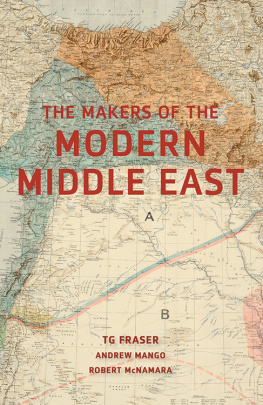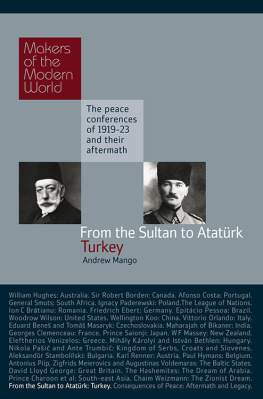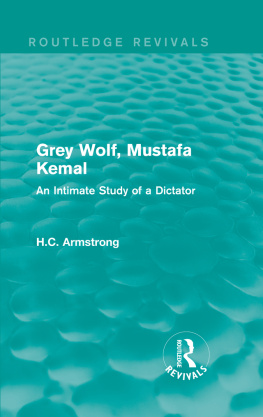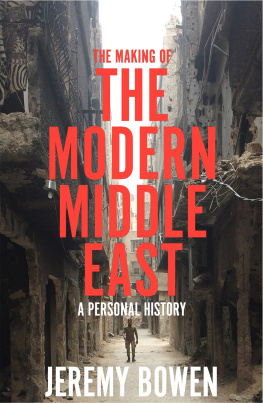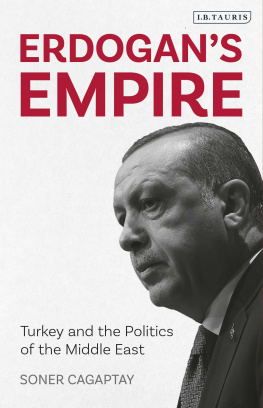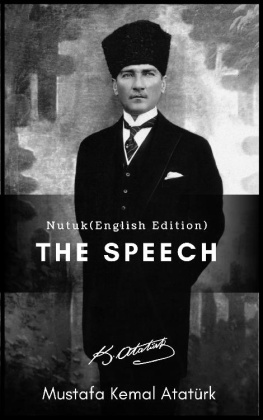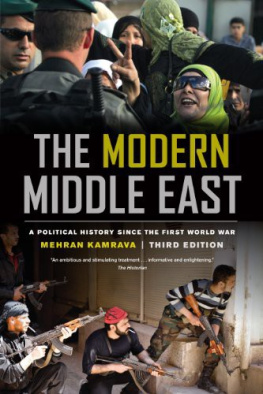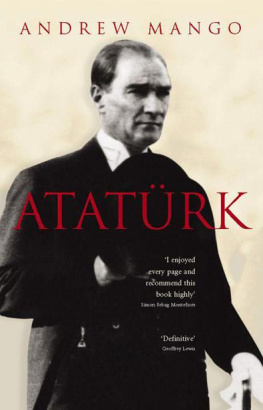Atatürk Kemal - Making the Modern Middle East
Here you can read online Atatürk Kemal - Making the Modern Middle East full text of the book (entire story) in english for free. Download pdf and epub, get meaning, cover and reviews about this ebook. City: Middle East, year: 2017;2015, publisher: The Gingko Library, genre: Religion. Description of the work, (preface) as well as reviews are available. Best literature library LitArk.com created for fans of good reading and offers a wide selection of genres:
Romance novel
Science fiction
Adventure
Detective
Science
History
Home and family
Prose
Art
Politics
Computer
Non-fiction
Religion
Business
Children
Humor
Choose a favorite category and find really read worthwhile books. Enjoy immersion in the world of imagination, feel the emotions of the characters or learn something new for yourself, make an fascinating discovery.
- Book:Making the Modern Middle East
- Author:
- Publisher:The Gingko Library
- Genre:
- Year:2017;2015
- City:Middle East
- Rating:5 / 5
- Favourites:Add to favourites
- Your mark:
- 100
- 1
- 2
- 3
- 4
- 5
Making the Modern Middle East: summary, description and annotation
We offer to read an annotation, description, summary or preface (depends on what the author of the book "Making the Modern Middle East" wrote himself). If you haven't found the necessary information about the book — write in the comments, we will try to find it.
Making the Modern Middle East — read online for free the complete book (whole text) full work
Below is the text of the book, divided by pages. System saving the place of the last page read, allows you to conveniently read the book "Making the Modern Middle East" online for free, without having to search again every time where you left off. Put a bookmark, and you can go to the page where you finished reading at any time.
Font size:
Interval:
Bookmark:

T G Fraser
with Andrew Mango and Robert McNamara
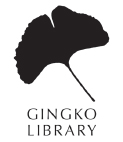
Historians have long known that the settlements negotiated at the end of the First World War had ramifications well beyond Europe. Much of Volume VI of H W V Temperleys monumental study A History of the Peace Conference of Paris, published in 1924, was devoted to the affairs of the Middle East and the attempts to set in place a peace settlement with the Ottoman Empire and its successors. As such, the contributors ranged across Turkey, Syria, Iraq, Egypt, Palestine and Persia, as well as the Zionist movement.
This book approaches the problem of post-war reconstruction from three very different perspectives; namely, the emerging but increasingly insistent claims of Arab nationalism, Turkish nationalism and Zionism. Whilst these movements, which recast the political shape of the region in spite of the imperial ambitions of the triumphant European powers, transcend any individual, three leaders emerged, who by any reckoning became the makers of the modern Middle East. The Hashemite Prince Feisal, with British encouragement, raised the standard of Arab nationalism against centuries of Turkish rule, only to see his hopes of an Arab kingdom destroyed, albeit with compensation for him in Iraq and for his brother in Transjordan. From an obscure university position in the north of England, the Russian-born scientist Dr Chaim Weizmann enlisted the support of key British politicians for a Jewish national home in Palestine in the shape of the Balfour Declaration, and then translated that document into a British League of Nations Mandate for Palestine charged with bringing it into effect. The Turkish soldier Mustafa Kemal came to prominence in the successful defence of the Gallipoli peninsula in 1915, and then went on to lead and inspire his countrys defiance of the victorious Allied powers to establish a modern, secular Turkish republic, becoming Atatrk, the Father of the Turks. What their movements achieved, and failed to achieve, are part of their legacies nearly a century later.
This volume was suggested to me by Dr Barbara Schwepcke of Haus Publishing, who realised that the deliberations of the post-First World War Peace Conference relating to the Middle East could be approached from three very different perspectives. This was apparent from three volumes she had published in The Makers of the Modern World series under the editorship of Professor Alan Sharp: namely, Andrew Mango, From the Sultan to Atatrk: Turkey; Robert McNamara, The Hashemites: The Dream of Arabia; and my own, Chaim Weizmann: The Zionist Dream. This book, thus, attempts to bring these studies together into an account of a seminal period of Middle Eastern history.
The Middle East is an area both of fascination and controversy. As an historian who has taught and researched its history at universities in Northern Ireland and the United States for over four decades, I have been lucky enough to have visited its countries many times, in the belief, taught me years ago by the late Professor L F Rushbrook Williams, that it is essential for a scholar to get the feel for the societies under review. His kindly interest in my work as an apprentice historian of the Middle East and South Asia is a memory I will always cherish. I have never encountered anything other than the hospitality for which the Middle East is justly renowned, and I retain the fondest memories of the people I have met and who have educated me in its affairs. If I have become convinced of anything, it is that those brought up in the West should have a proper appreciation of, and acknowledge, just how much world civilisation has owed to the contributions of the peoples of the Middle East.
Unfortunately, it is also a part of the world which has endured more than its fair share of turmoil and tragedy, and this, too, must be acknowledged and understood. Tragic events in the Middle East have become standard fare in the headlines for decades, and it is, alas, all too tempting to develop an indifference towards them, or worse. Such a path is neither realistic nor justifiable. This book proceeds from the belief that a sympathetic, but not uncritical, understanding of Middle Eastern affairs is a sine qua non for the informed citizen. The Makers of the Modern Middle East, then, analyses a critical series of events before, during, and after the Paris Peace Conference when the future shape of the Middle East as we have come to know it came into focus.
I am particularly grateful to my fellow authors Andrew Mango and Robert McNamara for their tolerance as I worked with their texts, and for their general advice. Barbara Schwepcke of Haus and Jaqueline Mitchell patiently encouraged me through the unfamiliar experience of making a coherent text from three volumes. Janet Farren deployed her customary skills in assisting with the preparation of the work for the publisher. The Series Editor of The Makers of the Modern World, Alan Sharp, read and commented on the text, as, amidst all the other priorities of academic life, did Dr Leonie Murray of the University of Ulster, saving me from many errors of expression and emphasis. Finally, my wife, Grace, was, as ever, an unfailing source of critical understanding and support.
T G Fraser, MBE
Emeritus Professor of History and Honorary Professor of Conflict Research,
University of Ulster
The Middle East on the eve of war
In 1900 the Middle East was barely, if we may borrow Prince Metternichs dismissal of Italy, a geographical expression. In the early 21st century its affairs could not be ignored. At the end of the First World War, the term Middle East was being used by the British, who had come to dominate the region as the result of military conquest, and it has since passed into common usage, which may serve as some defence against accusations of Eurocentrism. Definitions of the region have varied over time, but the limits of this book are marked by the boundaries of what was then the Ottoman Empire. The Turks emerged in the 8th century CE when the Seljuks, guided, according to national legend, by a grey wolf, conquered territories in central Asia. Their name is commemorated in the modern city of Seljuk in Anatolia. Converting to Islam, the Turks, led by the House of Osman, commonly known as the Ottomans, came into conflict with the Christian Byzantine empire, heir to ancient Rome. In 1453, the armies of Mehmed II, the Conqueror, took Constantinople, a pivotal event in world history.
At its height, the Ottoman Empire extended from the Turkish heartland in Anatolia across Egypt and North Africa, conquering much of the Arab territories as far as the Shatt al-Arab waterway, and in Europe pressing through the Balkans to the gates of Vienna. From his accession in 1876 until his forced abdication in 1909, the empire was ruled by Abdlhamid II, who, like the Habsburgs and the Romanovs, presided over a fascinating range of peoples and religions.
The Ottoman Empire in the new century
At the heart of Abdlhamids empire were the Turks, numbering, perhaps, some 10 million. The empire was ruled by the House of Osman, the Sultan uniting with his temporal rule the office of Caliph, or protector of the Islamic faith. Shias, the minority branch of the Islamic faith, believed that the true successors of the Prophet Muhammad were his son-in-law Ali and his descendants. The two cities held particular sanctity for the Shias since Ali was buried in Najaf and his son, Husayn, who had been killed in battle, was buried in Karbala. They found an affinity with those across the border in Persia, or Iran as it became in 1935, which was the main centre of Shia power. The Shias of the Tigris and Euphrates did not sit entirely comfortably in an empire in which the dominant Turks, as well as most Arabs, were Sunnis, and this was to pose problems in later years once independence came to the region.
Font size:
Interval:
Bookmark:
Similar books «Making the Modern Middle East»
Look at similar books to Making the Modern Middle East. We have selected literature similar in name and meaning in the hope of providing readers with more options to find new, interesting, not yet read works.
Discussion, reviews of the book Making the Modern Middle East and just readers' own opinions. Leave your comments, write what you think about the work, its meaning or the main characters. Specify what exactly you liked and what you didn't like, and why you think so.

